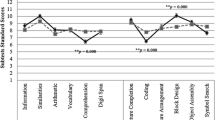Abstract
The relationship of play behavior to cognitive functioning in preschool developmentally disabled children was studied by comparing performance on Lowe and Costello's Symbolic Play Test (SPT) with that on the Bayley Scales and Stanford-Binet Scale. Subjects were 247 children referred for evaluation to a hospital-based child development clinic. Subjects were classified as midley retarded, moderately retarded, atypical, borderline, and language disordered. Correlations between the Bayley/Binet and SPT for the whole sample were significant and in the low to moderate range. Correlations between cognitive and play measures for each clinical group were in the low to moderate range, except for atypical children where the correlations were negligible. The retarded and borderline groups achieved similar mental ages on the Bayley/Binet and SPT but the language-disordered and atypical groups demonstrated marked differences in their Bayley/Binet and SPT functioning. Implications for using the SPT in clinical practive were discussed.
Similar content being viewed by others
References
American Psychiatric Association. (1980).Diagnostic and statistical manual of mental disorders (3rd ed.). Washington, DC: Author.
Bayley, N. (1969).Bayley Scales of Infant Development, New York: Psychological Corporation.
Clune, C., Paolella, J.M., & Foley, J.M. (1979). Free-play behavior of atypical children: An approach to assessment.Journal of Autism and Developmental Disabilities, 9, 61–72.
Cunningham, C.C., Glenn, S.M., Wilkinson, P., & Sloper, P. (1985). Mental ability, symbolic play, and receptive and expressive language of young children with Down's syndrome.Journal of Child Psychology and Psychiatry, 26, 255–265.
Doll, E. A. (1953).Measurement of social competence: A manual for the Vineland Social Maturity Scale. Circle Pines, MN: American Guidance Services.
Gould, J. (1986).The Lowe and Costello Symbolic Play Test in socially impaired children.Journal of Autism and Developmental Disabilities, 16, 199–213.
Hulme, I., & Lunzer, E. A. (1966). Play, language, and reasoning in subnormal children.Journal nal of Child Psychology and Psychiatry, 7, 107–123.
Jeffree, D., & McConkey, R. (1976). An observation scheme for recording children's imaginative doll play.Journal of Child Psychology and Psychiatry, 17, 189–197.
Largo, R. H., & Howard, J. A. (1979). Developmental progression in play behavior of children between nine and thirty months—I. Spontaneous play and imitation.Developmental Medicine and Child Neurology, 21, 299–310.
Lowe, M. (1975). Trends in the development of representational play in infants from one to three years—An observational study.Journal of Child Psychology and Psychiatry, 16, 33–47.
Lowe, M., & Costello, A.J. (1976).Manual of the Symbolic Play Test. Windsor, Berks, England: NFER.
Piaget, J. (1967).Play, dreams, and imitation in childhood. London: Routledge & Kegan Paul.
Radcliffe, J. (1984, April).Relationship of the Symbolic Play test to conventional ability tests. Paper presented at the annual meeting of the National Association of School Psychologists, Philadelphia.
Riquet, B. C., Taylor, N. D., Benaroyay, S., & Klein, L. S. (1981). Symbolic play in autistic, Down's, and normal children with equivalent mental age.Journal of Autism and Developmental Disabilities, 11, 439–448.
Terman, L., & Merrill, M. (1972).Stanford-Binet Intelligence Scale: Manual for the third revision (Form L-M). Boston: Houghton Mifflin.
Ungerer, J. A., & Sigman, M. (1981). Symbolic play and language comprehension in autistic children.Journal of American Academy of Child Psychiatry, 20, 318–337.
Ungerer, J. A., Zelazo, P.R., Kearsley, R. B., & O'Leary, K. (1981). Developmental changes in the representation of objects in symbolic play from 18 to 34 months of age.Child Development, 52, 186–195.
Whittaker, C. A. (1979). A note on developmental trends in the symbolic play of hospitalized profoundly retarded children.Journal of Child Psychology and Psychiatry, 20, 253–261.
Wing, L., Gould, J., Yeates, S. F., & Brierly, L. M. (1977). Symbolic play in severely mentally retarded and in autistic children.Journal of Child Psychology and Psychiatry, 18, 167–178.
Author information
Authors and Affiliations
Additional information
We thank Maxine Field, Nancy Fox, Jean Fridy, and two anonymous reviewers for their helpful comments. Also, we are grateful to Paul Crits-Christoph for his statistical consultation.
Rights and permissions
About this article
Cite this article
Power, T.J., Radcliffe, J. The relationship of play behavior to cognitive ability in developmentally disabled preschoolers. J Autism Dev Disord 19, 97–107 (1989). https://doi.org/10.1007/BF02212721
Issue Date:
DOI: https://doi.org/10.1007/BF02212721




